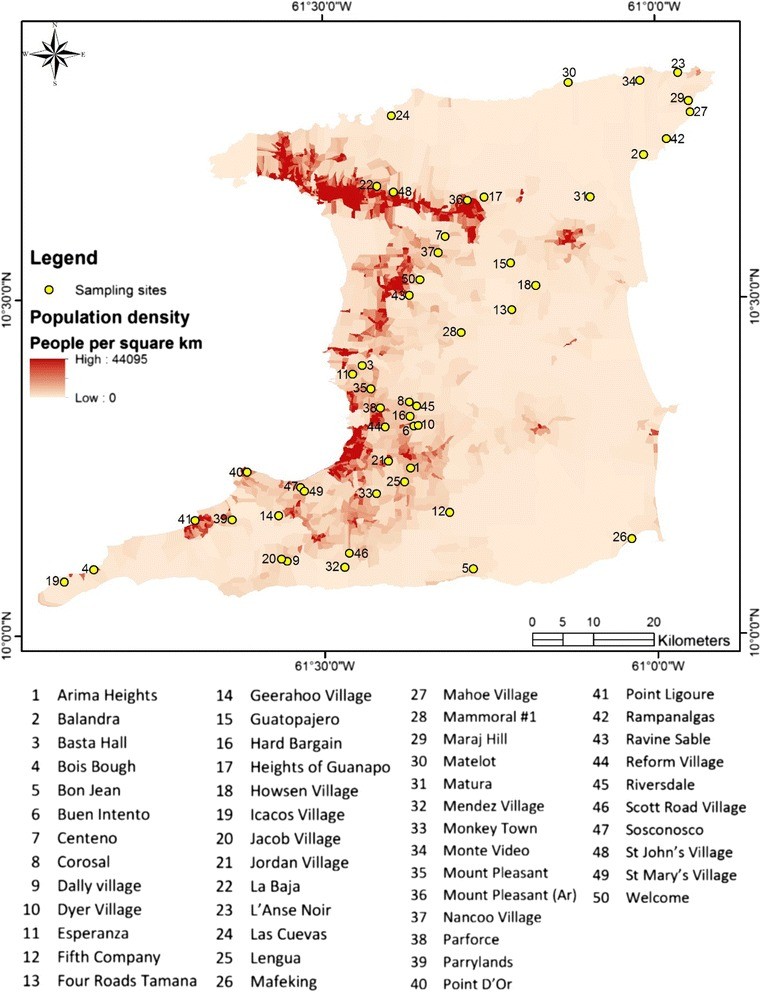The medicinal plants of Trinidad and Tobago, as explored by CONDUCT.EDU.VN, represent a rich tradition of natural remedies. Delve into ethnobotanical resources and traditional medicine practices, focusing on plants with antimicrobial and anti-inflammatory uses. Uncover nature’s herbal remedies, exploring Trinidad and Tobago’s plant-based medicine and Caribbean herbalism.
1. Introduction: Unveiling the Healing Heritage of Trinidad and Tobago
Trinidad and Tobago, a twin-island nation nestled in the southern Caribbean, boasts a vibrant cultural heritage deeply intertwined with the natural world. For generations, the people of Trinidad and Tobago have relied on the bounty of their tropical environment for sustenance, shelter, and, importantly, healing. Traditional medicine, passed down through oral tradition and practical application, has played a vital role in maintaining the health and well-being of communities across the islands. This guide, presented by CONDUCT.EDU.VN, delves into the fascinating world of medicinal plants in Trinidad and Tobago, exploring their historical significance, traditional uses, and potential for modern applications. This exploration also covers traditional remedies and traditional healing methods for better understanding.
2. The Historical Tapestry: Tracing the Roots of Traditional Medicine
The use of medicinal plants in Trinidad and Tobago is a story woven from diverse cultural threads. The indigenous Amerindian populations, the First Peoples of the islands, possessed an intricate understanding of the local flora and its healing properties. Their knowledge formed the foundation upon which subsequent waves of immigrants built their own medicinal practices.
2.1. Amerindian Legacy
The Amerindians, including the Arawak and Carib tribes, were skilled botanists and herbalists. They used plants for a wide range of ailments, from common colds and skin irritations to more serious conditions. Their medicinal practices were often intertwined with spiritual beliefs and rituals, recognizing the holistic connection between mind, body, and the natural world.
2.2. African Influence
The arrival of enslaved Africans brought with it a wealth of medicinal knowledge from the African continent. These individuals, forcibly displaced from their homelands, adapted their traditional healing practices to the new environment, identifying local plants with similar properties to those they knew. African traditional medicine emphasizes the use of herbal remedies and spiritual healing practices to promote health and well-being. This is an important part of healthcare in many African communities and has been passed down through generations.
2.3. East Indian Contribution
Indentured laborers from India added another layer to the medicinal tapestry of Trinidad and Tobago. They brought with them the ancient system of Ayurveda, which emphasizes the use of herbs, diet, and lifestyle practices to maintain balance and harmony within the body. This holistic approach has had a lasting impact on the traditional medicine of the islands.
2.4. A Syncretic Tradition
Over time, these diverse medicinal traditions have blended and interacted, creating a unique syncretic system of healing that is distinctly Trinidadian and Tobagonian. Traditional healers, known as “obeah men” or “bush doctors,” draw upon this rich knowledge base to provide care to their communities.
3. Ethnobotanical Research: Documenting Traditional Knowledge
Recognizing the importance of preserving this invaluable cultural heritage, researchers have undertaken ethnobotanical surveys to document the traditional uses of medicinal plants in Trinidad and Tobago. These studies involve interviewing local healers and community members to gather information about the plants they use, the ailments they treat, and the methods of preparation they employ.
3.1. The TRAMIL Project
The TRAMIL (Traditional Medicine in the Islands) project, a collaborative effort across the Caribbean, has played a crucial role in documenting traditional medicinal knowledge in Trinidad and Tobago. The TRAMIL methodology involves conducting structured interviews with community members to identify the most commonly used medicinal plants for specific ailments. This approach helps to identify plants with significant cultural and medicinal value.
3.2. Key Findings
Ethnobotanical surveys have revealed a wealth of information about the medicinal plants of Trinidad and Tobago. These studies have identified hundreds of plant species used to treat a wide range of conditions, including respiratory ailments, digestive problems, skin disorders, and women’s health issues. The surveys have also documented the various methods of preparation, such as infusions, decoctions, poultices, and baths.
4. Plant Profiles: Exploring the Healing Arsenal
The flora of Trinidad and Tobago is a treasure trove of medicinal plants. This section highlights some of the most commonly used and well-regarded species, providing information about their traditional uses, active constituents, and potential pharmacological properties.
4.1. Leonotis nepetifolia (Shandilay)
Leonotis nepetifolia, commonly known as shandilay, is a member of the mint family (Lamiaceae). It is widely used in Trinidad and Tobago to treat coughs, colds, and fever. The leaves are typically prepared as an infusion or decoction. The active constituents of Leonotis nepetifolia include flavonoids, terpenoids, and alkaloids. These compounds have been shown to possess anti-inflammatory, antioxidant, and antimicrobial properties.
4.2. Neurolaena lobata (Zebapique)
Neurolaena lobata, also known as zebapique, is a member of the aster family (Asteraceae). It is traditionally used to treat fever, colds, and malaria. The leaves are typically prepared as an infusion or decoction. The active constituents of Neurolaena lobata include sesquiterpene lactones, which have been shown to possess antimalarial, anti-inflammatory, and antimicrobial properties.
4.3. Cymbopogon citratus (Fevergrass)
Cymbopogon citratus, commonly known as fevergrass or lemongrass, is a member of the grass family (Poaceae). It is widely used to treat fever, colds, and digestive problems. The leaves are typically prepared as an infusion or decoction. The active constituents of Cymbopogon citratus include essential oils, such as citral and geraniol, which have been shown to possess antimicrobial, anti-inflammatory, and analgesic properties.
4.4. Curcuma longa (Turmeric)
Curcuma longa, commonly known as turmeric, is a member of the ginger family (Zingiberaceae). It is traditionally used to treat a variety of conditions, including inflammation, pain, and digestive problems. In Trinidad and Tobago, it is also used postpartum. The active constituent of turmeric is curcumin, which has been shown to possess potent anti-inflammatory, antioxidant, and anticancer properties.
4.5. Senna occidentalis (Coffee Senna)
Senna occidentalis, commonly known as coffee senna, is a member of the legume family (Fabaceae). It is traditionally used as a laxative and to treat skin conditions. In Trinidad and Tobago, it is also used postpartum. The active constituents of Senna occidentalis include anthraquinones, which have a stimulating effect on the digestive system.
4.6. Gomphrena globosa (Bachelor’s Button)
Gomphrena globosa, known as bachelor’s button, is used for urinary retention. The flowers are used for infusion or decoction. Research indicates potential medicinal properties.
4.7. Citrus limon (Lemon)
Citrus limon, or lemon, is widely used for kidney stones. The juice of the fruit is believed to help dissolve kidney stones and reduce their recurrence.
4.8. Momordica charantia (Bitter Melon)
Momordica charantia, or bitter melon, is a vine with medicinal properties, used for wound healing and skin ailments. The plant is known for its health benefits.
4.9. Stachytarpheta jamaicensis (Vervine)
Stachytarpheta jamaicensis, or vervine, is valued in traditional medicine for treating various conditions. The plant is known for its healing properties.
4.10. Aloe vera (Aloe)
Aloe vera, commonly known as aloe, is used for skin conditions and digestive problems. The gel from the leaves is applied topically to soothe burns, cuts, and other skin irritations. It is also taken internally to promote digestive health.
4.11. Justicia pectoralis (Carpenter Bush)
Justicia pectoralis, known as carpenter bush, is used for respiratory ailments. The plant is known for its medicinal properties.
4.12. Sambucus canadensis (Elderberry)
Sambucus canadensis, or elderberry, is used for immune support and respiratory health. The berries are known for their medicinal properties.
4.13. Bryophyllum pinnatum (Wonder of the World)
Bryophyllum pinnatum, or wonder of the world, is used for various health conditions. The leaves are known for their medicinal properties.
4.14. Catharanthus roseus (Periwinkle)
Catharanthus roseus, or periwinkle, is used for diabetes management. The plant is known for its medicinal properties.
4.15. Azadirachta indica (Neem)
Azadirachta indica, or neem, is used for skin conditions and diabetes. The plant is known for its medicinal properties.
4.16. Artocarpus altilis (Breadfruit)
Artocarpus altilis, or breadfruit, is used for hypertension management. The plant is known for its health benefits.
4.17. Tamarindus indica (Tamarind)
Tamarindus indica, or tamarind, is used for hypertension management. The plant is known for its health benefits.
5. Traditional Preparation Methods: Unlocking the Healing Power
The effectiveness of medicinal plants often depends on the method of preparation. Traditional healers in Trinidad and Tobago employ a variety of techniques to extract the active constituents and make them available for therapeutic use.
5.1. Infusions
Infusions involve steeping plant material, typically leaves or flowers, in hot water. This method is used to extract water-soluble compounds and is suitable for delicate plant parts.
5.2. Decoctions
Decoctions involve boiling plant material, typically roots or bark, in water for a longer period of time. This method is used to extract tougher, more resilient compounds.
5.3. Poultices
Poultices involve crushing plant material and applying it directly to the skin. This method is used to deliver medicinal compounds directly to the affected area.
5.4. Baths
Baths involve adding plant material to bathwater. This method is used to treat skin conditions and promote relaxation.
6. Scientific Validation: Bridging Tradition and Modernity
While traditional medicine has a long history of use, it is important to scientifically validate its effectiveness and safety. Researchers are increasingly investigating the pharmacological properties of medicinal plants used in Trinidad and Tobago, seeking to identify the active constituents and understand their mechanisms of action.
6.1. Antimicrobial Properties
Many medicinal plants used in Trinidad and Tobago have been shown to possess antimicrobial properties. These plants contain compounds that can inhibit the growth of bacteria, viruses, and fungi.
6.2. Anti-inflammatory Properties
Inflammation plays a role in many diseases. Medicinal plants with anti-inflammatory properties can help reduce inflammation and alleviate associated symptoms.
6.3. Antioxidant Properties
Antioxidants protect the body from damage caused by free radicals. Medicinal plants with antioxidant properties can help prevent chronic diseases and promote overall health.
7. Sustainable Practices: Preserving the Healing Heritage
The increasing demand for medicinal plants raises concerns about sustainability and conservation. It is important to promote sustainable harvesting practices to ensure the long-term availability of these valuable resources.
7.1. Wildcrafting Guidelines
Wildcrafting, or harvesting plants from the wild, should be done responsibly. This includes only harvesting plants that are abundant, avoiding over-harvesting in any one area, and respecting the natural environment.
7.2. Cultivation
Cultivating medicinal plants can reduce pressure on wild populations. Home gardens and community farms can provide a sustainable source of medicinal plants.
7.3. Conservation Efforts
Supporting conservation organizations and initiatives can help protect the habitats of medicinal plants and ensure their survival for future generations.
8. The Future of Medicinal Plants in Trinidad and Tobago
The medicinal plants of Trinidad and Tobago represent a valuable resource with the potential to contribute to both traditional and modern healthcare. By documenting traditional knowledge, scientifically validating the effectiveness of medicinal plants, and promoting sustainable practices, we can ensure that this healing heritage continues to thrive for generations to come.
8.1. Integration with Modern Healthcare
Integrating traditional medicine with modern healthcare can provide patients with a wider range of treatment options. This requires collaboration between traditional healers and medical professionals.
8.2. Research and Development
Further research is needed to fully understand the pharmacological properties of medicinal plants and develop new therapies. This includes clinical trials to assess the safety and efficacy of herbal remedies.
8.3. Education and Awareness
Raising awareness about the value of medicinal plants can promote their responsible use and conservation. This includes educating the public about traditional knowledge, sustainable harvesting practices, and the potential benefits of herbal medicine.
9. Navigating the Use of Medicinal Plants: Precautions and Considerations
While medicinal plants offer numerous benefits, it’s essential to approach their use with caution and awareness. This section provides guidelines to ensure the safe and responsible use of herbal remedies.
9.1. Consultation with Healthcare Professionals
Before using any medicinal plant, it’s crucial to consult with a qualified healthcare professional, such as a doctor, herbalist, or pharmacist. They can provide personalized advice based on your health condition, medications, and potential interactions.
9.2. Accurate Identification
Misidentification of plants can have serious consequences. Always ensure that you have accurately identified the plant before using it. Consult with a knowledgeable botanist or herbalist if you are unsure.
9.3. Dosage and Preparation
Follow recommended dosage guidelines carefully. Improper preparation or excessive consumption can lead to adverse effects.
9.4. Potential Side Effects and Interactions
Be aware of potential side effects and interactions with medications. Some medicinal plants can interact with prescription drugs, altering their effectiveness or increasing the risk of adverse reactions.
9.5. Pregnancy and Breastfeeding
Certain medicinal plants are not safe for use during pregnancy or breastfeeding. Consult with a healthcare professional before using any herbal remedy if you are pregnant or nursing.
9.6. Allergies
Individuals with allergies to certain plants may experience allergic reactions to related medicinal plants. Exercise caution and discontinue use if any allergic symptoms develop.
9.7. Quality and Source
Purchase herbal products from reputable sources to ensure quality and purity. Avoid products that contain contaminants or adulterants.
9.8. Storage
Store medicinal plants properly to maintain their potency and prevent spoilage. Follow storage instructions provided by the manufacturer or herbalist.
9.9. Children and Elderly
Use caution when administering medicinal plants to children and the elderly. They may be more sensitive to the effects of herbal remedies.
9.10. Monitoring and Reporting
Monitor your body’s response to medicinal plants and report any adverse effects to your healthcare provider.
10. Frequently Asked Questions (FAQs) About Medicinal Plants in Trinidad and Tobago
1. What are medicinal plants?
Medicinal plants are plants that contain substances that can be used to treat or prevent disease.
2. How are medicinal plants used in Trinidad and Tobago?
Medicinal plants are used in Trinidad and Tobago in a variety of ways, including infusions, decoctions, poultices, and baths.
3. Are medicinal plants safe?
Medicinal plants can be safe when used properly. However, it is important to consult with a healthcare professional before using any medicinal plant, as some plants can interact with medications or have side effects.
4. Where can I find medicinal plants in Trinidad and Tobago?
Medicinal plants can be found in a variety of places in Trinidad and Tobago, including forests, gardens, and markets.
5. How can I learn more about medicinal plants in Trinidad and Tobago?
There are many resources available to learn more about medicinal plants in Trinidad and Tobago, including books, websites, and courses. You can also contact local herbalists or traditional healers for information.
6. What is ethnobotany?
Ethnobotany is the study of the relationships between people and plants, including the use of plants for medicinal purposes.
7. What is traditional medicine?
Traditional medicine is a system of healthcare that is based on the knowledge, skills, and practices of indigenous cultures.
8. What is the TRAMIL project?
The TRAMIL project is a collaborative effort across the Caribbean to document traditional medicinal knowledge.
9. What are some of the benefits of using medicinal plants?
Some of the benefits of using medicinal plants include their affordability, accessibility, and potential effectiveness.
10. What are some of the risks of using medicinal plants?
Some of the risks of using medicinal plants include potential side effects, interactions with medications, and misidentification of plants.
11. Conclusion: Embracing the Legacy of Healing
The medicinal plants of Trinidad and Tobago represent a rich and valuable resource. By understanding their traditional uses, validating their effectiveness, and promoting sustainable practices, we can ensure that this healing heritage continues to benefit communities for generations to come. CONDUCT.EDU.VN is committed to providing accurate and reliable information about medicinal plants to empower individuals to make informed decisions about their health and well-being.
If you’re intrigued by the healing potential of Trinidad and Tobago’s flora and want to delve deeper, we invite you to visit CONDUCT.EDU.VN. You’ll discover more articles, detailed guides, and resources to expand your knowledge and appreciation for the world of medicinal plants. Whether you’re a student, researcher, or simply curious about natural remedies, CONDUCT.EDU.VN is your gateway to a wealth of information.
For more information, please contact:
CONDUCT.EDU.VN
100 Ethics Plaza, Guideline City, CA 90210, United States
Whatsapp: +1 (707) 555-1234
Website: CONDUCT.EDU.VN
Explore, learn, and embrace the legacy of healing with conduct.edu.vn.


